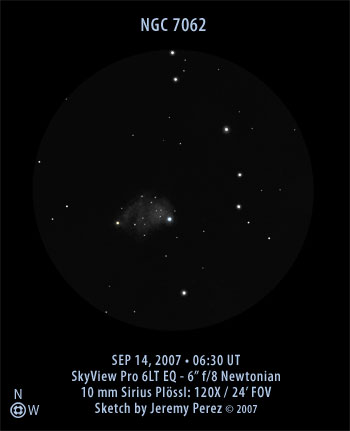
Click image for larger version.
Observation Notes:
This cluster showed up as a soft, grainy, elongated glow at 37.5X which became more resolved at 120X. It was elongated East-West with a PA of about 100 degrees. Its long dimension was about 6 arc minutes and was bracketed on the east and west by 2 bright stars–the western-most one glowing orange. A train of bright stars swept past the cluster to the west and was most striking at low power. While making the observation, the salty smell of brewing dog food from the Purina Plant put a periodic ruination on the observational feel-goods. Still, it was a beautiful cluster.
After the observation, I checked other reports and photos, and noticed that the eastern bright cluster star is shown as the brightest. However, when I observed it, the western orange star was brighter. After noticing this, I went back outside and checked it again to see if I had made a mistake; but it was definitely brighter. So I’d have to guess that one of the two is a variable star. The Concise Catalog of Deep Sky Objects notes that the cluster contains at least 8 δ Scuti type pulsating variable stars which it calls an “uncommonly large number”. I haven’t dug deep enough to see if one of the two brighter stars is part of that number, but that’s my hypothesis until I know better. The sketch includes 14 stars in the body of the cluster, with a total of 45 stars in the sketch overall.
[Edit – September 30, 2007]: Some great input from Eric Graff on this observation had me putting this cluster back into the eyepiece on the evening of September 21 to re-assess color on the bright western bounding star I had noted as orange. On this evening, the star definitely did not appear orange, but was pale blue in color. The eastern star also appeared to be pale yellow. I’ve updated the sketch to reflect this observation.
Object Information:
NGC 7062 was discovered by F.W. Herschel in 1788. NGC 7062 is also catalogued as Cr 434, Lund 988, OCL 205, H VII-51, h 2116, GC 4661.
| Subject | NGC 7062 |
| Classification | Open Cluster (II 2 m) |
| Position | Cygnus [RA: 21:23:27.4 / Dec: +46:22:43]* |
| Size* | 6′ |
| Brightness* | 8.3 vMag |
| Date/Time | September 13, 2007 – 11:30 PM MST (September 14, 2007 – 06:30 UT) |
| Observing Loc. | Flagstaff, AZ – Home |
| Instrument | Orion SVP 6LT Reflector (150 mm dia./1200 mm F/L) |
| Eyepieces/Mag. | 10 mm Sirius Plössl (120X) |
| Conditions | Calm, high smoke haze |
| Seeing | 5/10 Pickering |
| Transparency | ~ Mag 5.8 NELM |
| *References | NGC/IC Project |